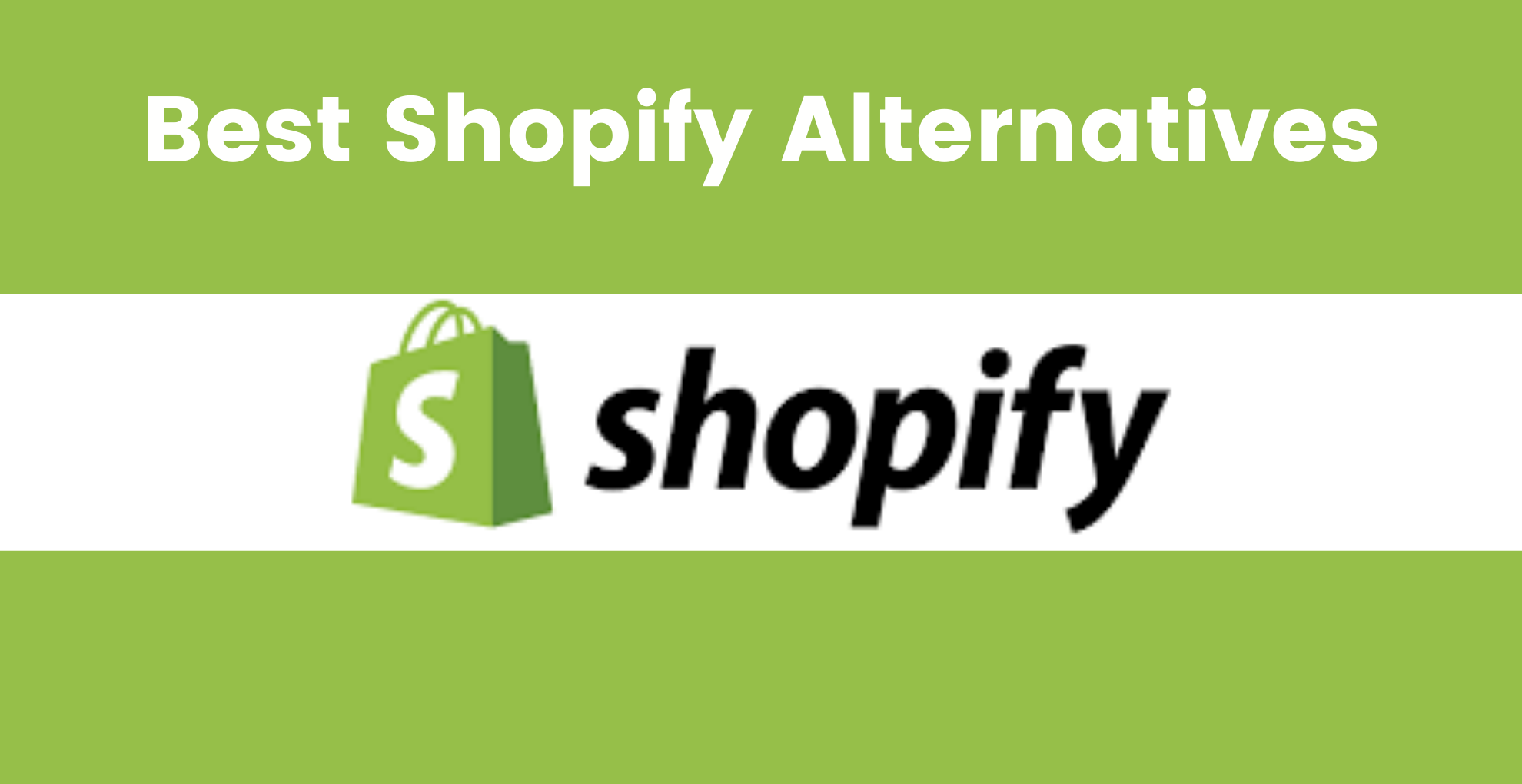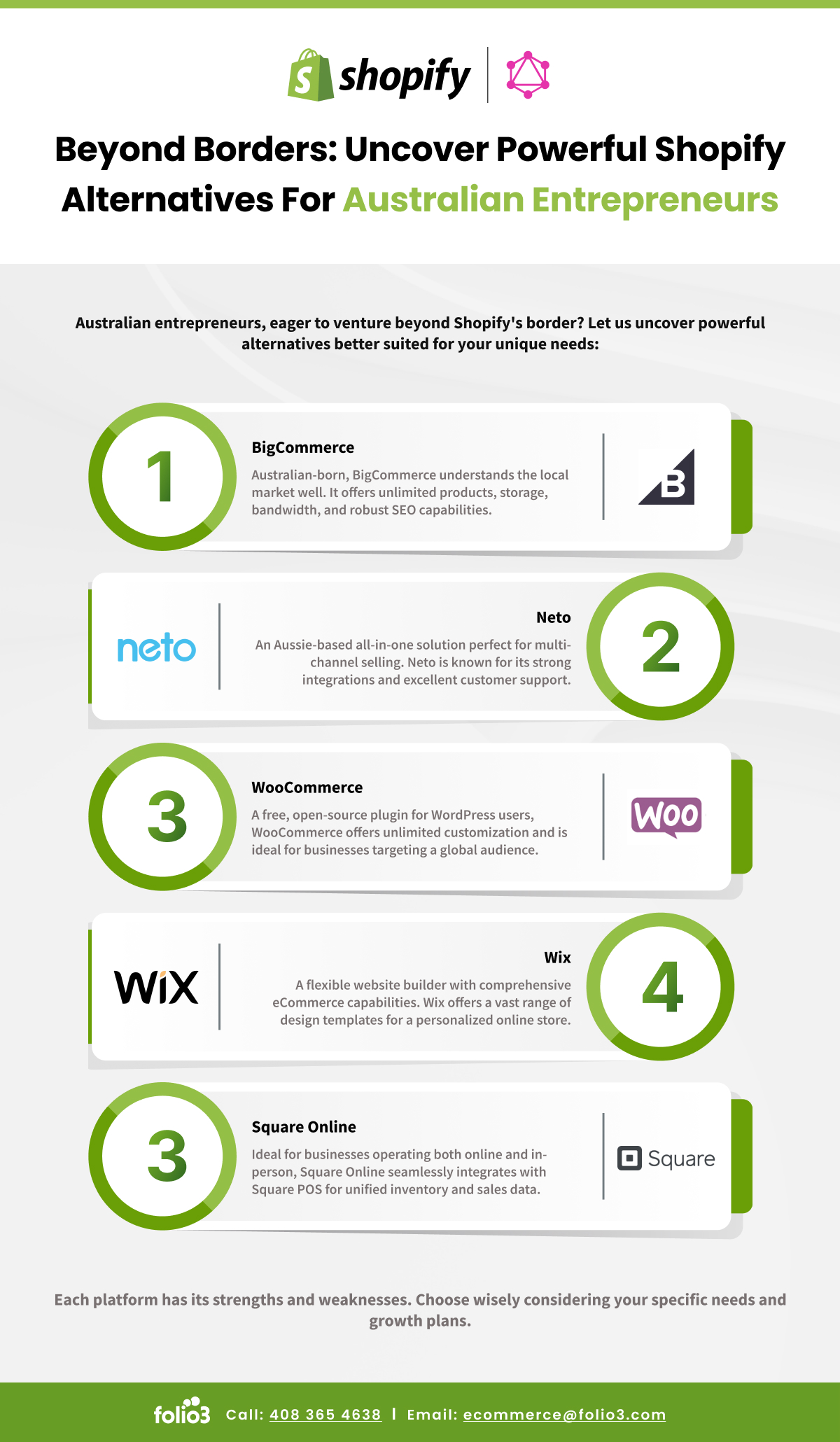Shopify Alternatives Australia: Top three alternatives to know about
Last Updated | January 16, 2024
Table of Contents
Shopify Alternatives Australia
Shopify is great – it has an amazing set of features, and it is exceptional (well, most of the time). Shopify helps create an online store and manage it, but just like other ecommerce platforms, it has a fair share of pros and cons (the biggest con is its ineffective functionality for Australian online stores). So, if you are looking for Shopify alternatives in Australia, you have come to the right place. In this blog, we are sharing the top three Shopify alternatives in Australia. So, let’s check out the details!
Beyond Borders – Uncover Powerful Shopify Alternatives for Australian Entrepreneurs
WooCommerce – The Review
To begin with, it’s one of the most famous e-commerce platforms on a global scale. For those who don’t know, it’s basically a plugin for WordPress websites since it helps transform the website into an online store. An online store made with WooCommerce helps capture a significant market share, and its open-source configuration makes it a good choice. As far as the plugin is concerned, it’s free for commercial as well as personal purposes. Since it’s a free plugin for WordPress websites, keep in mind that it doesn’t include an email, domain, theme, hosting, and support, which means there are some extra expenses to keep in mind.
WooCommerce Hosting Australia
-
Bluehost
When it comes down to WooCommerce, it’s essential to select and hire a promising hosting provider if you want hassle-free business operations. First of all, you can use Bluehost as they have been around 1996 and support more than two million websites (some of them include leading online stores). At this point, we do want to add the WordPress & WooCommerce bundles that have become the most convenient choices, and it’s actually great for people who don’t have technical skills. Moreover, Bluehost provides a complete walk-through of the store and hosting and beginners, and you will be able to complete the first few steps without any trouble. On top of everything, they have reliable customer support for people who need assistance.
-
SiteGround
SiteGround is another excellent hosting option for people who are developing a store through WooCommerce. They have designed advanced tools, such as automated updates and staging, to optimize the store. Secondly, they have optimized servers that promise top-notch performance. There are various security and speed features to help create a reliable, secure, and efficient store. Moreover, they have round-the-clock support available and can handle the beginner stores pretty well. As far as the features are concerned, they include free CDN, daily and automated backups, free SSL security, and GIT version control. On top of everything, they have a well-established data centre in Australia, which makes it an excellent choice for Australian stores.
Read Also Read Also SHOPIFY AUSTRALIA
WooCommerce Pricing & Fees Australia
WooCommerce is completely free for itself, but there are additional costs involved. First of all, there are maintenance costs associated with WooCommerce stores, such as SSL, domain name, hosting, storefront themes, developer charges, and plugins. For those who don’t know, hosting is basically a service for providing hardware and software for operating the website/store and make it public for the audience to see. For this reason, choosing the right hosting provider is crucial, and we have already mentioned two top hosting options. Also, the charges, pricing, and fees will depend on your desired features and hosting provider (yes, the prices will be different).
For instance, the hosting charges range from $5 to over $30. Secondly, you need to think about the domain because it’s another cost. For the most part, some hosting providers offer a free domain when you buy the hosting, but you can also buy the domain separately. Thirdly, you should think about the SSL certificates, and it’s essential for protecting and encrypting the critical business and customer data, such as server details, credit card details, and browsers. In most cases, SSL is free of cost when you buy the hosting, but if you have to buy the SSL on your own, it will cost anything from $8 to $70 for annual plans.
Read Also Best Alternative to Shopify
Lastly, you need to opt for DNS services. Generally, the store owners use the DNS service provided by the hosting provider, but you can also host the domain on bigger servers. It is suggested to opt for a third-party DNS service if your store is operating at a global scale because they help with traffic distribution according to the customers’ locations.
Convenient To Use
We have already mentioned that WooCommerce is an open-source platform which means you can install, update, manage, and optimize different store operations on your own. In addition, the store owners can keep the backup on their own. However, it’s important to add that installing WooCommerce is not as convenient as it sounds, and there might be some technicalities involved. For instance, you will need to create the database and install WooCommerce on the server through FTP configuration. However, once WooCommerce is installed, everything else will be handled more conveniently. That’s because the setup wizard will walk you through the configurations before you have to work on advanced settings. On top of everything, the interface is intuitive and user-friendly, and you can customize the entire store’s layout with a side control panel.
Read Also print on demand Australia
Customization & Themes
For setting up the WooCommerce store, it is crucial to select a suitable theme because the right design and high-performance dashboard will enhance the store’s value. WooCommerce allows the users to pick a theme for the store, and there is a well-designed theme marketplace with a wide range of free themes and premium designs. As far as the theme charges are concerned, they range from $20 to over $120, so you can create the store appealing according to your budget. The best thing is that WooCommerce supports and allows the installation of themes from third-party stores. Moreover, the users can easily switch the themes if it doesn’t comply with your needs.
Features
WooCommerce provides promising inventory management that allows the users to keep track of the inventory and manage the stocks easily. The store owners can easily handle the inventory report development and change the product details. With the inventory management feature, the users can create the variable store products and manage them while adding the quantity. Moreover, the Grouped Products is great for seamless inventory management and upselling.
Taxes & Shipping
As for the taxes, the WooCommerce store owners will have complete control over the implementation of taxes. The users can configure the settings with which taxes are calculated according to the shipping address and billing address. Various supported plugins are available for taxes, which means sales tax calculation will be optimized according to the customer’s location. Moreover, various plugins offer more robust monitoring, security, and in-depth insights.
As far as the shipping is concerned, there are three options available for WooCommerce users: flat rate, local pickup, and free shipping. With flat-rate shipping, the standard rates are set per order and item, while the local pickup option allows the customers to pick up the order or deliver rather than delivering the item to customers’ addresses. As for free shipping, it simply allows the store owners to set the free shipping. Not to forget, you can also experiment with the WooCommerce shipping plugin Australia.
WooCommerce Shipping Zones Australia
Shipping zones are defined as the primary area where the store owners can configure the shipping charges. This can be further refined by postcodes, states, and countries. WooCommerce owners can set various shipping options for every shipping zone so that the customers can select the most preferred choice.
WooCommerce Payment Gateway Australia
With WooCommerce, they are really upping their game with payment gateways. That’s to say because WooCommerce has its own payment solution, which works fine with WooCommerce stores. The payment gateway is free to download, and there are no monthly charges and setup costs. The customers can make secure payments through debit cards and credit cards and improve conversion rates through direct payment features. In addition to this, WooCommerce’s own payment gateway, there are hundreds and thousands of payment processors and extensions.
Analytics
WooCommerce analytics allow the store owners to get in-depth reports about the store orders, revenues, categories, products, downloads, inventory, and coupons. The analytics are easily available in the dashboard, so store owners can view the graphs and charts and export them. Moreover, the store owners will be able to customize the reports for product categories and types. The store owners have the capacity to export the data in CSV format for importing the spreadsheet. Furthermore, you can connect WooCommerce with Google Analytics to get information about the visitors. Not to forget, it allows the store owners to track the website and store performance right through the dashboard.
Extensions & Plugins
There is an extensive range of supported extensions and plugins to enhance the functionality. As of today, there are more than four hundred paid and free plugins for different store operations, such as marketing, store management, and payments. The utilization of these extensions and plugins will improve the store conversions and enhance the appearance of the WooCommerce store. On top of everything, you can select the extensions and plugins according to your location (yes, Australian stores have specific supported extensions and plugins), rating, and budget. As far as the plugins are concerned, the store owners can check out the in-depth features, reviews, and setup instructions. As for the charges of extensions, the price ranges from $30 to over $300.
WooCommerce Dropshipping
WooCommerce dropshipping Australia is actually a common concern, and it’s an excellent platform for dropshipping. First and foremost, the cost of starting a dropshipping business on WooCommerce is pretty economical as you only have to pay for domain, hosting, add-ons, and themes. The best thing about dropshipping through WooCommerce is that it’s an open-source platform that provides complete control, and there are no restrictions associated with the products. Not to forget, it’s a flexible platform that allows easier customization for everyone, and there won’t be a need to depend on third parties for controlling and monitoring the dropshipping business.
Read more about Shopify dropshipping in Australia here.
To summarize, WooCommerce is a good choice, but it might need some technical expertise to set it up, which means you have to hire WooCommerce or Shopify website development in Australia. Other than this, the functionality and security are flawless. Last but not least, it’s a great choice if you have a limited budget and are operating a large-scale ecommerce store through WooCommerce. So, just hire the WooCommerce or Shopify app developer Australia, and you will be good to go!
BigCommerce – The Review
When we talk about eCommerce platforms, it’s hard not to speak about BigCommerce because it’s one of the most prominent options out there. It has all the features you need to operate an online store because you only need to sign up. The store owners can also personalize the eCommerce store and monetize it to earn revenues and profits. It wouldn’t be wrong to say that BigCommerce is an all-rounded solution with top-notch features, such as online payment, product management, analytics, and order fulfilment. Moreover, there are professional themes available so that you can customize the store. BigCommerce also has high-end security and is fully optimized to host online stores with thousands of products and multiple product categories. For this reason, it has become an excellent choice for online stores that need to operate at scale and the stores undergoing the growth phase.
BigCommerce Pricing Australia
When it comes down to the pricing, the final pricing depends on various factors, such as the number of sales on an annual basis. That’s because BigCommerce offers three pricing plans which make it suitable for various businesses and industrial scales. The basic plan is priced at $29.95, while the most expensive plan costs around $225. It doesn’t matter which pricing plan you choose; the store will help create a responsive site, SEO tools, one-page checkout, in-depth analytics, and digital wallets. On top of everything, there are no transaction charges associated with BigCommerce stores, while BigCommerce offers 10% discounts if you select an annual plan rather than a monthly plan.
BigCommerce also provides a free trial period for fifteen days, but you cannot purchase anything during this trial period. In addition, keep in mind that every pricing plan has a specific threshold limit. This is because, with the plus plan and standard plan, you can only earn less than $50,000 and $180,000, respectively. On the other hand, if the sales go beyond this level, you need to update the pro plan (it charges around $300 if the store is making over $450,000 in a month). However, if the threshold is passed, you have to pay no less than $150 for a month every time sales exceed $200,000.
There is an enterprise plan available with BigCommerce, which is a suitable choice for large-scale companies. However, there is no cost set for the enterprise plan because it depends on the features. As far as the features are concerned, the advanced ones include reporting tools, priority support, IP address, SSL certification, and product filtering. So, do consider BigCommerce fees Australia when selecting a pricing plan.
Payment Gateways
BigCommerce currently offers three payment methods for accepting the credit cards, such as Square POS, PayPal with Braintree, and default payment solution. In the section below, we are sharing in-depth details about different payment gateways, such as;
-
PayPal
It is powered by Braintree and provides a wide range of benefits as compared to third-party payment gateways. For instance, the BigCommerce store owners can get preferential rates for credit card payments, depending on the pricing plan and one-page checkout. For example, the standard plan has 2.9% charges, plus plan has 2.5% charges, and the pro plan has 2.2% charges (all of them have 30c on top).
-
Third-Party Payment Method
BigCommerce store owners can opt for the payment gateway integrations, and there are currently more than 65 integrations available. Moreover, some mobile wallets and digital wallets can also be used, such as Amazon Pay, Apple Pay, and Venmo. When it comes to BigCommerce, store owners can select the refund type and secure the credit information, while the transactions cannot be disputed.
-
Square POS
This is the free payment gateway app that allows store owners to expand brick-and-mortar businesses into online stores. To begin with, the users can create the products and import them to the online store. Secondly, the store owners can export the products from the online store to Square POS, and the entire inventory can be properly synced.
Themes
There is an extensive range of templates available with BigCommerce, depending on your budget. For instance, small online stores can have access to over one hundred paid themes, and the prices range from $150 to $250. The best thing about BigCommerce themes is that all of them are responsive, aesthetic, and can be customized easily. The store owners can easily customize the themes to make them aligned with the store. A style editor feature allows the store owners to customize the carousel, fonts, and colors.
On top of everything, one can personalize and customize the themes without any coding. The store owners can control the background color, logo placement, available products, colors of navigation arrows, and much more. Last but not least, if you can work with HTML and CSS, the theme can be updated as well.
Ease of Use
The best thing about BigCommerce would be the ease of use. There is an extensive range of features but keep in mind that it’s not for beginners; you might need some technical expertise. For instance, there is a dashboard available which passes you through the setup and installation process. With these instructions, you will be able to set up an online store pretty easily. Currently, BigCommerce is supported by the Stencil framework, which means it’s handled much better by advanced users and people with more technical expertise. Not to forget, it allows the store owners to add the products, manage the tax rates, and configure the shipping settings.
BigCommerce is known to have a slightly complicated design interface which hinders its utilization. The dashboard is basically divided into two parts. The first part helps control the BTS factors of the online stores, such as discounts and products, while the second part helps customize the storefront. However, even with all these technicalities, a new page builder is available that offers easy customization options for beginner users. In addition, this page builder helps provide access to the template files, support the template editing, and drag-and-drop the content into different banners, buttons, content/text blocks, and HTML blocks. But again, you must be familiar with the basic technical terms or else you will spend hours figuring out the installation and setup.
Read more on setting up an online store in Australia on Shopify
Features
BigCommerce is loaded with a plethora of ecommerce features that are essential for online stores. In the section below, we are sharing some of the best BigCommerce Australia features, including the following;
-
Product Management
BigCommerce allows the store owners to import the brand products, set up tracking features for inventory, gain insights into product selling trends, and update the stock levels with the basic instructions. The store owners will be able to track the inventory between offline channels as well as an online channel since there are managing tools available. The store owners can also edit the product details, and there is no need to pay for third-party apps.
-
Order Processing
BigCommerce can help advance the business processes whenever a visitor from the audience click the buy button. It allows the store owners to process the orders, pack the slips, and print the invoices. It wouldn’t be wrong to say that it can handle the complete orders through the process until the fulfilment phase is achieved. Keep in mind that it’s an essential feature, particularly the online stores with hundreds and thousands of products.
-
Multi-Currency Support
This is another amazing feature associated with BigCommerce, which helps the store stand out and put it on the way to becoming the leading online store. BigCommerce has partnered up with five payment gateways for supporting multiple currencies. This feature actually helps the store owners to improve the foreign sales, and the currency will be automatically transformed into the native currency of the customers. Not to forget, multi-currency support is available for every BigCommerce store, irrespective of their subscribed pricing plan.
-
Multi-Channel Support
This is an essential feature for eCommerce stores, especially if they are in the growth phase. This feature can be integrated into the BigCommerce store, allowing store management on social media platforms, such as eBay, Instagram, Facebook, Amazon, and Pinterest. In addition, you will be able to keep track of sales from different sales channels and gain insights through the reporting tools. Also, you will be able to track the performance, identify the trends, and keep an eye on the conversion rates. Last but not least, there are various BigCommerce eBay Australia integrations and BigCommerce Amazon integration Australia.
Shipping & Taxes
BigCommerce has designed an extensive range of shipping solutions, such as shipping quotes for more expensive pricing plans. It has curated an all-in-one solution for shipping tools. In particular, ShipStation is a free app that allows store owners to get special discounts and are partnered with FedEx, DHL, and USPS. As a result, you will be able to keep the customer base satisfied by providing various options, such as free shipping, store pickup, shipping tracking, and next day delivery. Not so long ago, BigCommerce has also launched a new shipping feature, such as FedEx Express, for improved accuracy and more discounts. In addition, it helps set up the tax calculation rules, and you can connect the online store with a third-party tax integration for automating BigCommerce Australia VAT calculation and other taxes.
Apps
It might sound surprising to you, but BigCommerce has bagged over nine hundred apps for different categories and industries, such as taxes, accounting, shipping, marketing, and fulfilment. There are various free apps available, but the paid apps range from $20 to $30. What we love about BigCommerce is that it provides a free trial period for various apps without even making a payment. That being said, you can test different apps to see if they are suitable for your online store or not.
Security & Support
Whenever you sign up for BigCommerce free trial, you will get an instant email, and the support team will be there to discuss your business, its objectives and share the growth strategies. Moreover, the support services are available round-the-clock through phone, email, and live chat. As for the support, there are various forums available to discuss things with other users. As far as security is concerned, every website and store hosted on BigCommerce are compliant with level-1 PCI, and there is an SSL certification available to secure the store.
Read Also hire Shopify Development Company in Australia
Magento – The Review
According to research, around 20% of the eCommerce stores and sites are operating through Magento, and that’s some significant market share right there. For the most part, Magento is famous for its expandability and flexibility, which means you can add whichever feature you want. Given these features, you will be able to handle the business growth by adding new features. Magento is a prime choice for store owners who don’t have much technical and programming expertise, but advanced people can use it just fine.
Interface & Setup
Magento stores are integrated with intuitive systems and features, which makes them easy to use, but the setup time is pretty long. For instance, when you first sign up for the trial, you will have the option to stage the website according to the target audience. You will also get access to the dashboard with which you will be able to add the products and personalize the storefront. As for adding products into the Magento store is concerned, it’s convenient, and a robust system allows the users to optimize the formatting and work on cross-selling and upselling. What we love about Magento is an easy user interface which helps put information in specific areas, so you don’t need to shift back and forth (if you don’t know how to handle the setup, you can hire Folio3 as they are the top Shopify Migration company Australia but can work on Magento stores as well).
Secondly, Magento offers a wide range of page templates, so you can simply add the date with the help of a drop-down menu. In addition, you have the option to set up and save the page as a template. However, the pages are generally cached into the app’s cache for improved loading time (it’s convenient for customers, but it’s frustrating for developers). You can also check the Magento marketplace, where there are more than 1700 extensions, and more than 500 of them are available for free. The free extensions are designed with email alerts, push notifications, two themes, and connections to improve the stores’ appearance.
Features
Magento is one of the most popular eCommerce platforms with multiple features and has everything in store for various industries and businesses. In the section below, we are sharing the most prominent and effective features of Magento, such as;
-
Marketing
The store owners can set the coupons, and there is much-needed flexibility for creating the codes and coupons. Magento stores can create and identify the customer group according to their locations and demographics. The dashboard will help check the compared products and recently viewed products according to the customers’ choice. There is a feature for wish list sharing, which means the customers can send out the wish lists through email. Also, the social button sharing will help check the customer’s data on social media.
-
SEO
With the SEO features, the Magento store owners can set the mapping for optimizing the online rankings. The URLs are customizable, which means the URLs can be rewritten and tweaked for search engine optimization. Last but not least, the meta-information can be set, which means you can select and update data for every page separately.
-
Admin
With the admin feature, the Magento stores offer multi-store support, which means you can manage various websites through one account, while the printing feature allows the printing of labels, invoices, and packing slips. What we love about this feature is that you can use the CSV file for seamless migration, and the permissions can be managed to provide different features to the users.
Learn how folio3 can help you set up Shopify print on demand business in Australia
-
Inventory Management
Magento stores offer seamless support for multiple product types so that the store owners can create bundles and groups. The store owners can add much product information as they want. Secondly, the product sorting will be streamlined, and you can set up the pricing rules (provide discounts on different products). Lastly, the store owners can display the product pictures for the customers.
-
Analytics & Checkout
It is essential to keep an eye on the customer information and other analytics, which brings us to this feature that allows integration with Google analytics. There are in-built reporting features available for abandoned carts, taxes, and sales. The Magento stores are extremely responsible since the base design is entirely compatible with the themes. There is a one-page checkout feature available for an easier and efficient ordering process. However, you can also customize the checkout to comply with the webs design and store. Lastly, there is the order tracking features for tracking the verified orders.
Pricing
There are various versions of Magento available for the store owners. To begin with, there is Magento Open Source which is available for free, and one can easily create the Magento website. Secondly, there is a commerce plan that’s one robust plan. The commerce plan is suitable for growing businesses, and there are endless features available. However, before we move forward, let us tell you that Magento pricing Australia is different according to the features. To summarize, a commerce plan is suitable for large-scale or growing businesses, while open source is better for small businesses.
However, even with the open-source plan, you have to pay for the themes, hosting, and additional advanced features (you need to keep the additional Magento costs Australia in mind). In addition to these features, the store owners have to pay for the SSL security and domain name while payment processing partners will also charge.
Payment
With Magento, the users will be able to provide shipping, guest checkouts, and one-click payments. There is also a “bill me later” feature for helping the customers and financing the purchases. In addition, Magento stores can be integrated with Authorize.net and PayPal for easier payments, and the shipping chart will show the shipping charges and tax calculation. On the other hand, you will need to buy additional features and integrations for debit card processing and credit card processing, so those charges are additional.
Customer Support
When it comes down to Magento stores, Magento support Australia is pretty great. That’s to say, because the customer support team is available round-the-clock. Moreover, customer support is available by email and phone call, but they only cater to the sales questions. This means that if you are having issues with the performance and functionality, you have to wait because their technical support is slow and hardly available. However, if the store doesn’t show any errors, you won’t have any other issues!
Hosting
For Magento hosting Australia, you have two amazing options, naming Cloudways and Hostinger. First of all, Cloudways has more than sixty data centres available, and one is also based in Australia. Cloudways offer unlimited apps, free security certificates (SSL encryption), free migration, and backups are automated. Moreover, the security patching is regularly. The second hosting option is Hostinger which has the most affordable hosting plans available for the Magento store. Hostinger delivers a user-friendly dashboard, free SSL encryption, SSD storage, and quick loading times!
Wrapping It Up
To summarize, this article has covered everything you need to know about three top alternatives for Shopify stores, especially for the eCommerce stores based in Australia. We have shared all the pros and cons of different eCommerce platforms, so just weigh the features, pros, and cons to make value-based decisions.
FAQs
Is there a free alternative to Shopify in Australia and New Zealand?
When it comes down to a free alternative for Shopify in New Zealand and Australia, you can opt for Wix. However, Wix has some limitations, so; instead, you may want to opt for Magento, BigCommerce, and WooCommerce.
What is Shopify biggest competitor in Australia and New Zealand?
Some of the biggest competitors include Salesforce, Adobe(Magento), BigCommerce, Oracle, and SAP.









